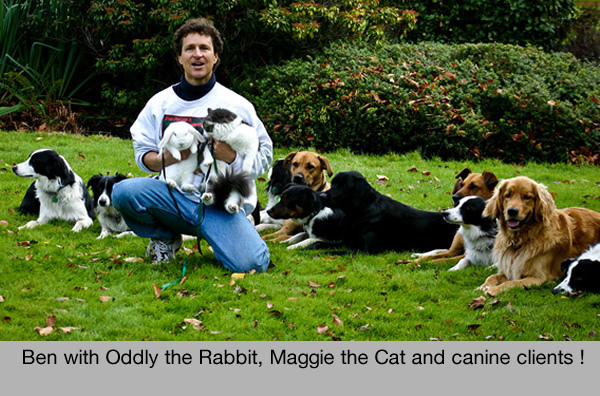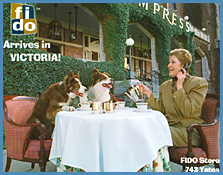WONDERDOGS TRAINING LTD
ADDITIONAL SERVICES WE OFFER
Wonderdog Run Club
Is your dog overweight or out of shape? Time to join the Wonderdog Run Club! This service is more than a run in the park! There is a lot of training that goes into teaching the dogs to run off leash as a pack ignoring distractions along the way.
The Victoria Wonderdog Run Club takes place on Saturday mornings at 9:30AM. Contact us for location.
Ben and the dogs run for one to two hours. This service is by donation only with all proceeds going to World Vision Click here for more information. Payment will not be made out to Ben – all proceeds will go directly to World Vision. Contact us for information on how you can get Run Club for free by helping serve up our meals for the homeless.
- There will be a pickup and drop off service available for a small additional charge (usually around $7/trip depending on where you live).
- You also have the option of picking your dog up at noon or 5:30PM instead of right after run club. Your dog will arrive home very tired and happy!
- Wonderdog Run Club meets rain or shine!
- All owners will need to bring proof of inoculations or titer testing.
- Clients are not required to participate but may join the run if fast enough!
Contact us to register! See you at Wonderdog Run Club!
Dog Walking Service Victoria BC
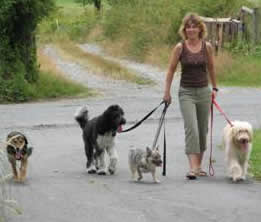 Short on time? We come to your home at hours that are convenient to you and do the walking for you.
Short on time? We come to your home at hours that are convenient to you and do the walking for you.
Ben doesn’t walk he runs! To find out more about Ben’s wonderdog run club click here.
Pet Sitting in Your Home
We are also available upon request to do pet sitting in your home. We will collect your mail, water the plants, feed and exercise your animals, administer their medication and spend the night. This is a great way to make sure your home looks lived in while ensuring the best care possible for your pets while you are away.
The cost for this service depends on the number of pets, work entailed and the location of your home. Please phone or email us for more information.
Entertainment Wonderdogs Style!
The Wonderdogs have performed their fast-paced, action-packed trick and frisbee show all over North America at sports events, conventions, fairs, parades, schools, and private parties. To read testimonials click here.
Contact us for more information and rates.
The show that you and the “Wonderdogs” put on, is action packed and we appreciate how you involve the audience….the way you adapt your show to your surroundings, and the occasion, is also really neat!
Mark McMillan
Extra Attractions Coordinator
Saanich Fair, Saanich, BC
Dogs for Movies, TV, and Advertising
Over the past 18 years, the Wonderdogs team has worked with dogs for the movie, television and advertising industry. We can usually supply a dog of any size, breed, or colour—whether crossbreed or purebred—within 48 hours of your request. Contact us for more information and rates.
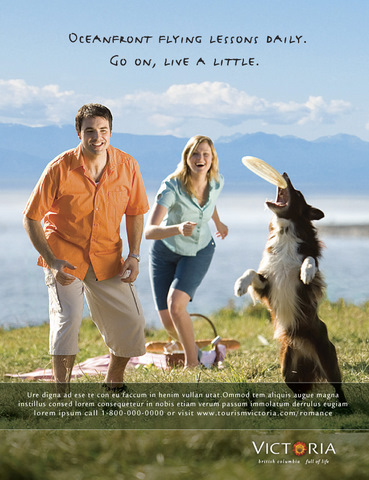
Joey stars in an ad for Tourism Victoria – September 2007
Dear Ben,
Shiloh and Fozzie in Fido cell phone commercial
I just wanted to take a minute to thank you for helping with our Fido promotion on March 28th. Your presence in the store was a very positive experience for our company. The dogs are truly “Wonderdogs”—watching customers react to them was wonderful! There wasn’t one person who didn’t smile at their presence. As well, a number of them stayed in the store longer than they typically would have without the dogs here.
The dogs were also a positive factor to our sales team. From a morale standpoint, they loved having the dogs around. They were a great ice-breaker with customers! From a sales standpoint, we sold more Fido phones on that day than we had ever sold on one day before (a 400% increase!)
I am excited about having they Wonderdogs back to the store for other promotions as the year continues.
Sincerely,
Walter Nicholson
Marketing Manager, CompuSmart,
Victoria, BC
Dear Mr. Kersen:
I’m writing to thank you for your excellent work on the Island Farms commercial. Your dogs performed admirably, and learned the difficult trick in very little time. The final commercial is a great success, and the client is thrilled. I look forward to working with you again.
Best regards,
Andrew Samuel
Art Director,
Copeland Communications,
Victoria, BC
Centra Gas advertisement
Ben,
I thought I’d take this opportunity to thank you for the great job you did in providing us with excellent “canine” talent for our recent advertising campaign for Centra Gas. Your professionalism and ability to achieve what we were looking for in a very timely and cost effective manner was really appreciated. I look forward to working with you again, and would not hesitate in recommending you to any other company looking for your services.
Sincerely,
Deborah Bowman,
Account Manager/Public Relations
Broughton Communications Group
Victoria, BC
Shiloh in Harbour Towers advertisement
Ben made the photo shoot with his star actor “Shiloh” as easy as rolling out of bed on a beautiful summer morning. We are thrilled with the results and think this campaign will be very strong for us. I wish all the models we ever worked with were that well behaved. Thanks Ben and Shiloh. We couldn’t have done it without you.
Lidia Laidlaw
Marketing Manager
Harbour Towers Hotel and
Ocean Point Resort Hotel and Spa
Victoria, BC
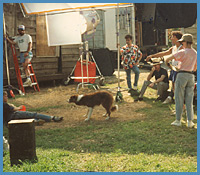
Ben and Shae on set at Tri-Star Pictures in Hollywood, auditioning for “Bingo”
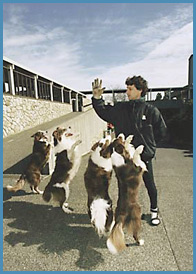
Ben and Wonderdogs at University of Victoria for Fido promotion
Dog Training Seminars
We have hosted numerous training seminars across North America. These seminars made the news on radio, television and newsprint in each city we have visited with the Wonderdogs.
Ben displayed a high level of initiative as he was the driving force to promote the seminar and ensure that many Scottsdale citizens benefited from this new concept in dog training. This event was a benefit to all Scottsdale dog owners! I would recommend him for any endeavor in which he is interested.
Doug Nesselroad
Recreation Coordinator
City of Scottsdale Arizona, USA
For more testimonials click here.
Diplomas of completion will be awarded to all participants.
For years, students have come to us from Europe, Southeast Asia, the USA and all points in between to learn how to become a Professional Dog Trainer. Our training has made news across North America! To view Ben Kersen’s career highlights, click here.
Safety & Training Tips
“Be careful.” “Don’t fall dear.” “Look out for the…” These were the constant reminders during my childhood from my dear mother. Despite her best intentions, I managed to acquire my share of scraped knees and bumped foreheads.
As doggie parents, we are responsible for our four-legged children’s safety. Speaking of children, could you imagine leaving a young toddler to play near traffic without supervision? If you love your dog, and want to enjoy its company to a ripe old age, I would encourage you to take the same precautions as you would for a baby and more—dogs are MUCH faster!!
All the good nutrition, training, and your loving care can be destroyed instantly by an accident if your dog isn’t safety trained. This newsletter offers general suggestions, but should not be used instead of going for active training with a qualified trainer.
SAFETY TIPS
[pl_accordion name=”Safety Tips”][pl_accordioncontent name=”Safety Tips” number=”1″ heading=”Safety Outside Cars” open=”no”]
Do you remember being taught as a young child to look both ways before crossing the street? Picture the scene: you are playing fetch with your dog. The ball gets knocked out into the street and your dog races after it unaware of anything else including the approaching car.…
Over one million dogs are hit by motor vehicles annually. This statistic should be a big incentive for you to car-proof your dog.
Car proofing teaches your dog:
- To jump back whenever a vehicle comes directly toward it.
- Never to go off curb onto asphalt unless you given your “okay”.
- To always sit at every curb before crossing the road.
These three techniques can be taught quite easily and are invaluable in saving your dog’s life. For instance, Part “A” can be taught in two 20-minute sessions.
Car proofing is a service that Ben Kersen and the Wonderdogs provide. This consultation can be done in our office or by telephone.
If your dog is not car-proofed, you should ALWAYS use a leash when walking near traffic. The only exception is a dog that has been through advanced training.
[/pl_accordioncontent][pl_accordioncontent name=”Safety Tips” number=”2″ heading=”Safety Inside A Car” open=”no”]
If you were involved in a car accident, would your dog be safe? If your dog is free in the car, it could be thrown into a window, out of the car, or otherwise injured.
There are alternatives:
- Traveling crates: many people crate their dogs in a vehicle. Remember this is only going to be helpful if the crates themselves are thoroughly secured to the body of the vehicle.
- Seat belts: there are now a variety of dog seatbelt products that can be used in conjunction with human seat belts.
- Dividers: in station wagons and vans, dividers can be secured in a vehicle to create a special place for your dog. In pick-up trucks, your dog(s) may ride in a sturdy, canopy-enclosed box.
Traveling crates, dog seat belts, and dividers can be purchased at most pet shops. Of course, these alternatives are only going to work if you use them consistently. If you have two or three dogs, ‘ buckling up ‘ before every drive can be time consuming. You will need to judge the value of the companionship and petting time you and your dog (s) share when they can sit beside you against the need for these vehicle safety measures.
Heat in Cars
If the temperature rises to 20°C outside, a dog left in a car may be at risk. With direct sunlight, the temperature in your car will rise dramatically. Even with all four windows open, a dog can suffer heat stroke very quickly on a hot day. Heat stroke can be fatal. In hot weather, parking in the shade or using sun reflector blankets to cover the front window can help, but they are no guarantee of safety. Always avoid leaving your dog in a hot car for its comfort, as well as its safety.
Car Windows
The “‘Houdini Dog'” syndrome can strike if you leave your car windows open too wide. The rule of thumb is that the window should not be open wider than the dog’s head. If a dog can get its head out the window, then it CAN get the rest of its body out.
Car Doors
Just a reminder: car doors are heavy and can cause serious injury. So when putting “Fido” in the car, hold the door until you are absolutely sure that all dog parts and the entire leash are well inside the car. Also, never slam the car door. Close it slowly holding the handle in case of “doggie door dash”.
Car Manners
When driving, the last thing you need is a hairy projectile ricocheting around the car. Also, never let your dog fire out through the car door as soon as it is opened. Teach him/her to sit and wait until given your “okay” to exit safely. Car manners are easily taught with a little time and consistency. This a service that Ben Kersen and the Wonderdogs provide.
[/pl_accordioncontent][pl_accordioncontent name=”Safety Tips” number=”3″ heading=”Safety in Your Home” open=”no”]
Training collars (choke chain) should only be used for training. These collars need to be fitted properly so they fit snug over the dog’s head. Dogs can get a training collar that is too long caught on a shrub in the yard or on furniture in the house. If the dog is unsupervised, it may panic, and this can be fatal.
Feed your dog after exercising, not before. When a dog has a full stomach then starts to exercise, the stomach can ‘flip’ or the stomach can bloat — often a fatal condition.
Chocolate, though yummy for people, can be poisonous for dogs. Semi-sweet chocolate in very small quantities can be fatal; milk chocolate isn’t quite as toxic but can still kill a dog.
Poison Proofing
Dogs are natural-born scavengers, and they will head for the worst things: a spot of antifreeze in a driveway(usually fatal), a discarded chicken bone, chocolate, etc. Because scavenging is such a natural instinct, poison proofing is a vital part of your dog’s training.
There are two ways to poison proof:
- teach your dog to take food from your hand only and never to scavenge for food on the ground; or
- if you have to be away or kennel your dog at times, you can teach your dog never to scavenge for food on the ground, but allow it to take food from other people.
Poison proofing is a service that Ben Kersen and the Wonderdogs provide with consistent results. This consultation can be done in our office or by telephone.
There are also many houseplants and some outdoor plants are poisonous. Most nurseries have lists of these. Before you bring a puppy home, you will want to make an inventory of plants around the house.
The following is a list of plants that can be toxic or fatal to dogs:
| Aloe Vera Amaryllis Apple (seeds) Apple Leaf Croton Apricot (pit) Asparagus Fern Autumn Crocus Avocado (fruit and pit) Azalea Baby’s Breath Bittersweet Bird of Paradise Branching Ivy Buckey Buddhist Pine Caladium Calla Lily Castor Bean Ceriman Charming Dieffenbachia Cherry (seeds and wilting leaves) Chinese Evergreen Christmas Rose Cineraria Clematis Cordatum Corn Plant Cornstalk Plant Croton Cuban Laurel Cutleaf Philodendron Cycad Cyclamen Daffodil Devil’s Ivy Dieffenbachia Dracaena Palm Dragon Tree |
Dumb Cane Easter Lily (especially in cats!!!!) Elaine Elephant Ears Emerald Feather English Ivy Fiddle-leaf fig Florida Beauty Foxglove Fruit Salad Plant Geranium German Ivy Giant Dumb Cane Glacier Ivy Gold Dieffenbachia Gold Dust Dracaena Golden Pothos Hahn’s Self-Branching Ivy Heartland Philodendron Hurricane Plant Indian Rubber Plant Janet Craig Dracaena Japanese Show Lily (especially cats !!!) Jerusalem Cherry Kalanchoe Lacy Tree Philodendron Lily of the Valley Madagascar Dragon Tree Marble Queen Marijuana Mexican Breadfruit Miniature Croton Mistletoe Morning Glory Mother-in Law’s Tongue Narcissus Needlepoint Ivy Nephytis |
Nightshade Oleander Onion Oriental Lily (especially in cats!!!) Peace Lily Peach (wilting leaves and pits) Pencil Cactus Plumosa Fern Poinsettia (low toxicity) Poison Ivy Poison Oak Pothos Precatory Bean Primrose Red Emerald Red Princess Red-Margined Dracaena Rhododendron Ribbon Plant Saddle Leaf Philodendron Sago Palm Satin Pothos Schefflera Silver Pothos Spotted Dumb Cane String of Pearls Striped Dracaena Sweetheart Ivy Swiss Cheese Plant Taro Vine Tiger Lily (especially cats!!!) Tomato Plant (green fruit, stem and leaves) Tree Philodendron Tropic Snow Dieffenbachia Weeping Fig Yew |
[/pl_accordioncontent][pl_accordioncontent name=”Safety Tips” number=”4″ heading=”Puppy Proofing the House” open=”no”]
Before bringing puppy home, it’s important to check each room of your house for items that may be hazardous. All household cleaners, bleaches, oils, chemicals of any sort should be kept in a high, and preferably locked cupboard.
All electrical cords should be dabbed with jalapeño pepper juice, lemon juice, bitter apple, or some other substance that will taste terrible to the chewing puppy. If you have a Mexican dog or a dog that just won’t take “no” for an answer, try “DAVE’S INSANITY SAUCE”, and your dog will be blowing smoke rings for hours!! (this sauce is available in the specialty food section of most grocery stores).
It is important to have lots of chew toys for puppy (as an alternative to your furniture and electrical cords). However, with the exception of Kongs and some of the hard rubber Nylabones, almost any chew toy will break down under determined chewing. Be sure to replace such toys before they become small enough to be swallowed.
[/pl_accordioncontent][pl_accordioncontent name=”Safety Tips” number=”5″ heading=”Safety Outdoors” open=”no”]
Some dogs like to play with rocks. Avoid playing fetch or throwing rocks for your dog to catch. Also, avoid letting your dog chew on rocks… all of these activities can damage the dog’s teeth.
Do not allow your dog to run up to strangers or dogs until you ask permission (some people are petrified of dogs). This is simply considerate when meeting new people and or dogs, also many dogs have not been socialized and may be aggressive toward your dog.
Check areas where you are walking. If you have any suspicion that there is broken glass in the area, take care to avoid it, or simply leave the area. A glass cut to the paw may take several months to heal due to constant use.
In hot weather, take care about how much exercise your dog gets. Dogs are more susceptible to heat exhaustion or heat stroke than humans. You need to consider how vigorously your dog normally exercises, how long, and what exercising habits your dog has in judging how much it should do in hot conditions. As mentioned earlier, heat stroke can be fatal for dogs. You may want to spray your dog down when going for a run, and take water for dog and human.
If you are hiking with your dog, remember to evaluate the area beforehand. If you’re walking high trails, make sure the paths are easy enough for the dog to get down as well as up. Also, avoid throwing anything that might go over the edge of a cliff; your dog may not stop to look. If you are hiking in a desert with cacti, make sure to bring leather gloves and long-nosed pliers to remove cactus spines from paws.
[/pl_accordioncontent][pl_accordioncontent name=”Safety Tips” number=”6″ heading=”Safety in a New Environment” open=”no”]
Always keep your dog on leash and under control when in a new area or situation. For example, when traveling or camping, your dog can become disoriented and could run off and get lost.
Dog Theft
Again, treat your dog as you would a young baby! Would you leave your baby unattended for 1/2 an hour while shopping? Although dog theft is not a big problem in smaller centers, it can be in large cities. Let common sense prevail and an acute awareness of where your dog is and for how long. The same concept applies to leaving your dog in an unlocked vehicle.
Lost Dog Syndrome
Is your yard secure? You would be amazed to know how many dogs escape from their yard never to be seen again. Test your containment system “under fire” (be it fence, dog run, etc.). Have a friend or neighbor run by with their dog, bait with food treats, ball, etc….
A dog chained or tied up in the back yard can cause discomfort or injury to the dog. Here are some alternatives:
- Wood or Chain-Link Fencing: A determined dog can jump mind-boggling heights. When deciding on fence height, consider your dog’s age and how much more will he/she will grow. Getting a 45 ° degree overhang on the top of the fence will make a big difference for a chronic jumper. Also, dogs are amazing excavators. Whether using chain link or treated lumber, always install the fence 12 inches below ground level.
- Clothesline Kit: These are available at most pet shops and enable your dog to run the length of the clothesline without becoming entangled. If you are on a limited budget, this will cost a fraction of fencing while safely containing your dog.
- Electric Fencing: This is a system using an underground, electrically charged line around the perimeter of your property in conjunction with a collar that the dog wears, which delivers an electrical shock. Some dog owners subscribe to electric fencing because it is effective for their particular dog. Other dog owners are not so fortunate. Some of the disadvantages include:
- Malfunction—this happens quite infrequently, but remember, you are dealing with an electronic device. With time, wear, or water, the possibility of malfunction will increase. If the collar is triggered and remains on, it will cause severe trauma and can be fatal to your dog.
- Your dog sees a bird or squirrel outside the property line, charges, and has gained so much momentum by the time it reaches the perimeter that it crosses the line and is afraid to come back. Some dogs will become anxious and run away.
- Many dogs won’t eat for days after receiving one or two shocks because they are so traumatized. For this reason, many trainers (including myself) are averse to any type of shock training.
Perimeter training teaches your dog three things:
- To stay within your property boundary at all times regardless of the temptation or distraction.
- To stay away from certain areas of your yard (flower beds, etc.).
- To stay out of certain rooms in your home.
Perimeter training is a service that Ben Kersen and the Wonderdogs provide. This consultation can be done in our office or by telephone.
If you have a safety tip, please email us. We would love to hear from you! Happy tails and trails!!
[/pl_accordioncontent][pl_accordioncontent name=”Safety Tips” number=”7″ heading=”‘Halti’ or ‘Gentle Leader’ Candidates” open=”no”]
If you want a well trained dog but don’t like the training collar, there is a great alternative – a”halti’ (also referred to as Gentle Leader). Many dog owners find the halti gentler than a training collar. A halti is very similar to a horse’s harness and works on the same principle. As soon as your dog starts to pull, the head turns towards you. You can get a halti at most pet shops.
There are four types of dog owners that should use the halti instead of the training collar:
- Those that are forgetful! The training collar works like magic only if you are 110% consistent and snap everytime your dog is pulling;
- Those who will give a very mild or slow snap, for fear of hurting their dog, etc. The training collar only works if the snap is lightning fast;
- Those who have trouble snapping the leash because of a physical problem such as tendonitis, arthritis, bad balance, etc.;
- Those who have a very powerful and/or large dog. The halti is like power steering compared to the training collar for those mule or moose-like dogs!
If you fall into most, or all four, of the above categories, please do your dog a favour — go with the halti.
WARNING: Your dog will hate the Halti with a passion if you take any shortcuts here. It will take most dogs 3 times longer to get used the halti than to a training collar. Knowing this, it is very important that you practice the following instructions every day until your dog is completely relaxed with the halti.
The best time to get your dog acquainted with the halti is after a good run because he will have burned off excess energy. Now give your dog a really nice belly rub for 2 minutes so your dog is even more relaxed. Have an assistant clip the halti on while you keep scratching the tummy. Be sure your dog is on leash and can’t run and hide under the bed. So long as your dog is totally relaxed, you can keep the halti on as long as you wish. When your fingers are tired (or after a few minutes), take the halti off, then skip the belly rub (in that order). Repeat this as often as you can throughout the day, even if it’s a 3-4 minute session. The second day repeat. The third day, try putting it on without the belly rub. If your dog starts pawing at it, try to distract him with a food treat or with a favourite toy. If you can’t get his attention after a few seconds, go back to the belly rub. After the fourth or fifth day, your dog will probably be fine wearing the halti around the house. Start to have him wear it around the house on a regular basis. Day six or seven, clip the leash on the halti and go for a “walk” in your yard where there are no distractions. Use food treats and favourite toys, run backwards, clap your hands, jump around like a clown. Use a”Squeaky” and animated voice. Your neighbours will think you are nuts but your dog will love you! After two days of “walks’ in your yard, start walking in your neighbourhood; after anotherday or two start to snap if your dog is pulling. Follow this method and your dog will love the Halti!! If you take shortcuts, your dog will never tolerate the Halti.
When you first put the halti on, be very, very sure it is adjusted tight enough that your dog can’t paw or rub it off. If your dog gets it off one time, they will always remember this victory and there will be no end to the pawing, etc. For this reason, never take the halti off when your dog is pawing or struggling with it. Only take it off when your dog is relaxed and not struggling.
Your dog can wear either the halti or the training collar around the house or yard as long as you are present. There is a slim possibility that the collar or halti will get caught on an object and injure your dog. All the more reason to buy the correct size to ensure a snug fit.
[/pl_accordioncontent][pl_accordioncontent name=”Wade Training Collar” number=”8″ heading=”Wade Training Collar” open=”no”]In all of my years training, I haven’t seen any new training equipment come out that has proved to be much of any improvement from what was available over 30 years ago when I started training. About a year ago, we were contacted by Wade Collars and given a sample collar which remained unused until recently. When we did try it out, we were pleasantly surprized. It works like a fursaver collar, only it’s not chain, it’s a leather-like material. Not only does it fit better because you can adjust it to exactly how tight you would like it, it also stays up high on the dog’s neck better as it’s not as slippery as chain. It is also more comfortable for the dog and it is safer. Another bonus is when you unclip to do off-leash, there is no change in what the dog feels as the leash isn’t what is keeping it tight. Watch the video clip below for more information:

